Vladivostok is one of Russia’s easternmost cities, and it is an interesting city, and in many ways a trip here is like being in Europe despite its location on the Russian Pacific coast. In this way you experience both the rich Russian culture and local history and culture.
For many visitors, Vladivostok is the same as the terminus of the Trans-Siberian Railway and thus the destination of a great journey. It is, too, but the beautifully situated metropolis has so many sights, museums and activities that it is worth visiting by itself without necessarily taking on the 9,288 km/5,771 mile long train journey from Moscow.
A walk along the main street of Svetlanskaya is a must when being in Vladivostok. Here you will see many of the beautiful constructions from the early 20th century Vladivostok. The walks along the water and the view from Eagle’s Nest Hill must also be a part of the stay, and you should also have the walk to Egersheld Lighthouse on the city bucket list, here you have the sea on all sides.
Vladivostok’s surroundings are also exciting with good opportunities for activities. For example, you can take the Trans-Siberian Railway to the west and just get off in Khabarovsk or another station close to the city. The city’s oceanarium is also worth a visit, and the borders with China and North Korea are also in close distance from here.
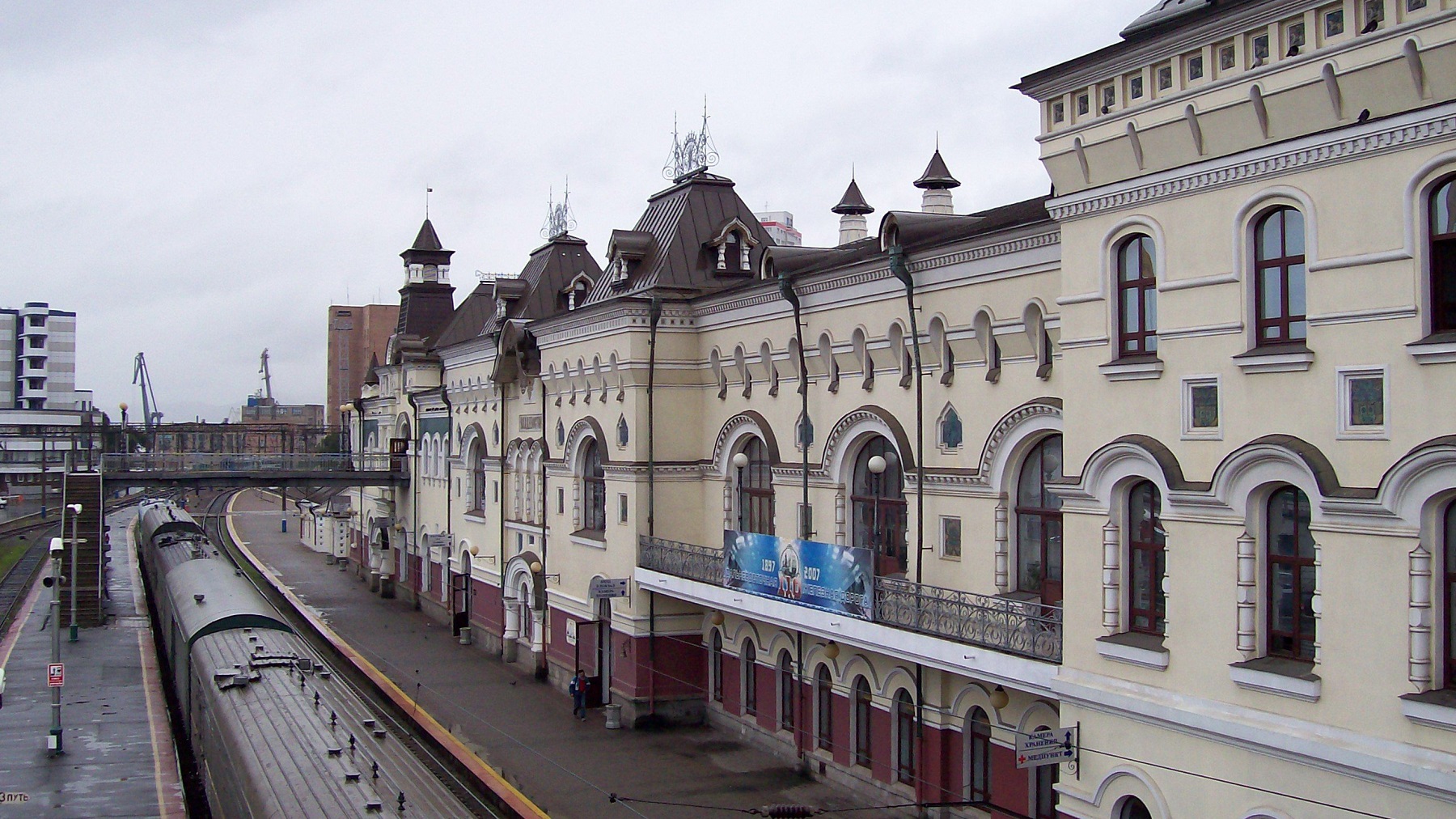
Vladivostok Railway Station is one of Russia’s most famous railway stations. It is the eastern terminus of the Trans-Siberian Railway, reaching 9,288 km/5,771 miles from Moscow. The railway station was planned in connection with the construction of the railway from European Russia through Siberia to the Pacific Ocean.
The foundation stone was laid in 1891 by the later Tsar Nicholas II. The station was opened in 1893, and it was rebuilt in the years 1910-1912 in the same design as the Yaroslavl railway station in Moscow to mark both ends of the railway line.
The promenades along the harbor and the sea are some of Vladivostok’s most popular places, and there are beautiful views, sights and lots of activities at the promenades.
The most visited embankment is probably Sportivnaja Naberezhnaja with cafes, street life and a music fountain. You can also walk along the Korabelnaya Naberezhnaya/Корабельная Набережная with monuments and the Soviet submarine S-56.
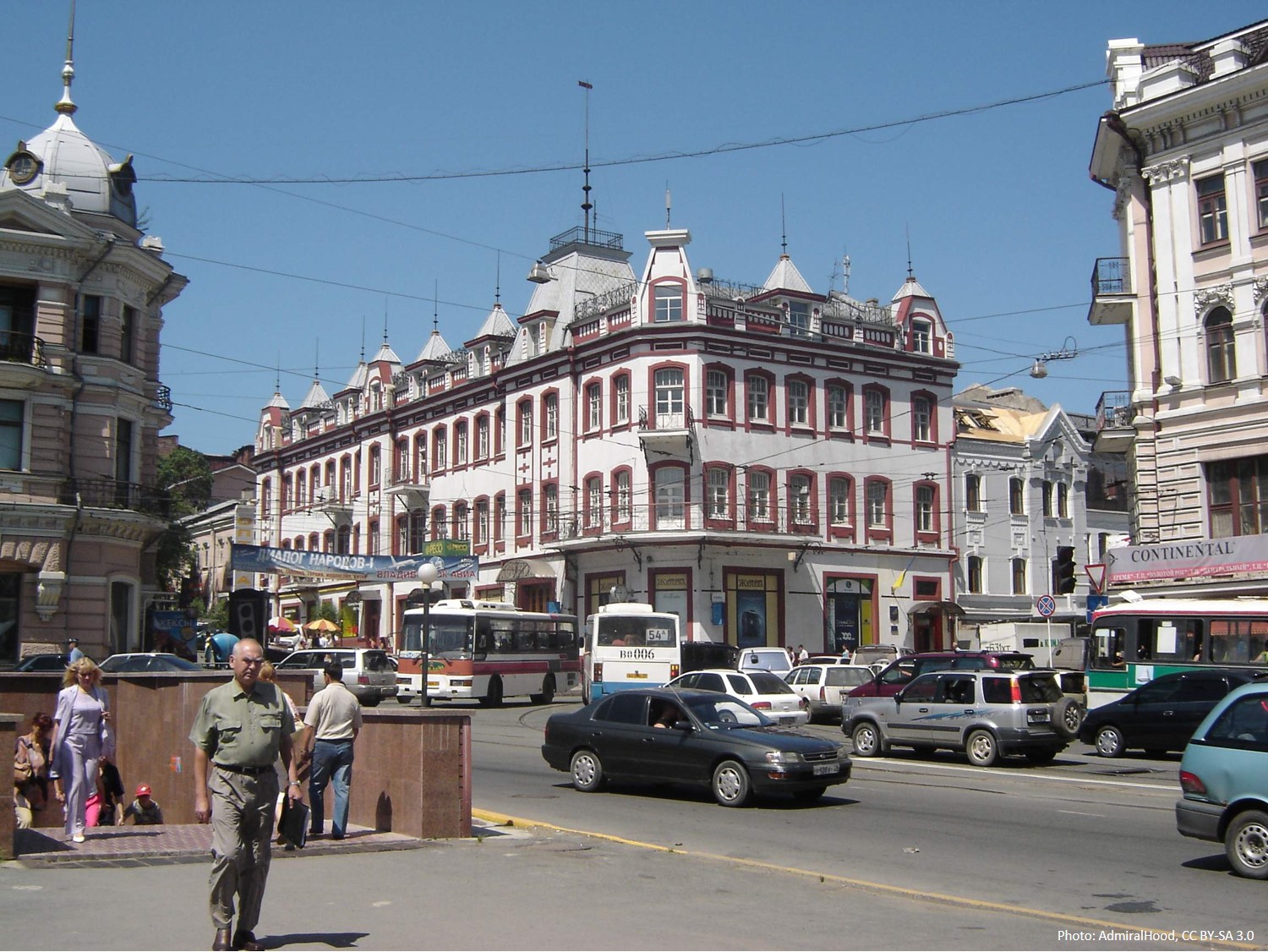
If you want to take a walk in central Vladivostok, the street of Svetlanskaya is a good place to start. It runs through most of the city and serves as one of the main streets. The street was originally named Amerikanskaya, but was given its current name in 1873 from the frigate Svetlana, which brought Grand Duke Alexei Alexandrovich to the city in 1873.
During Soviet times, the street was named after Lenin. The original wooden houses from the 19th century no longer stand here, but you can see many fine buildings from the 20th century; eg Hotel Central/Цостиница Централь from 1906-1907. Historically, it was also here that trams ran, and where the city’s cinemas and department stores opened.
At the end of the 19th century, a cemetery was built outside the city. Here, Orthodox, Catholics, Protestants and others were buried, and in 1902 a church was built here. The cemetery was closed down in 1929-1932, and the church was blown up in 1935.
Instead, a park was laid out with a ferris wheel and a statue of Lenin. After the Soviet era, the present church was built on the foundations of the old church, and it is today the city’s cathedral. The cathedral is located in Pokrovsky Park/Покровский парк, where you can go for a nice walk.
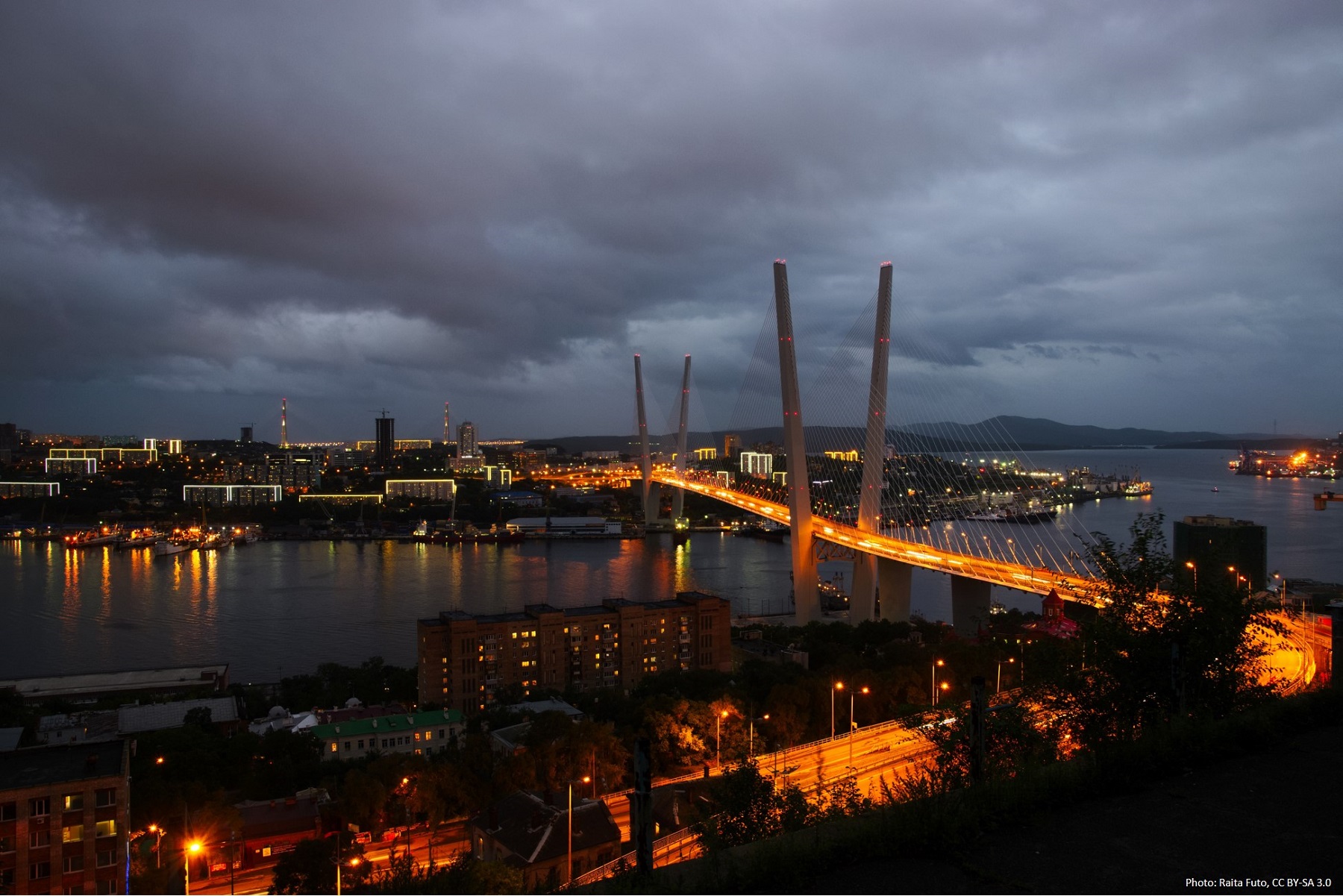
The Eagle’s Nest Hill is the highest point in central Vladivostok, and it is worth walking or driving up here, where there is a viewing platform with an incomparable view of the city and the area surrounding it. The mound itself is the remains of an extinct volcano, and from here you can see parts of the city port, the Zolotoi Most bridge and the sea.
At the viewing platform there is a monument to St. Kiril and St. Methodius, who created the Russian alphabet. In addition to the viewing platform itself, you can walk around the hill and see parts of Vladivostok in almost all directions.
At this museum you can get acquainted with the history and culture of the Primorsky Krai region. The museum’s exhibitions spans time from descriptions of the Balhae Kingdom, which from 698 was a part of present-day Primorsky Krai, Manchuria, and North Korea. Here are also fine archeological finds and cultural history from the region’s various peoples.
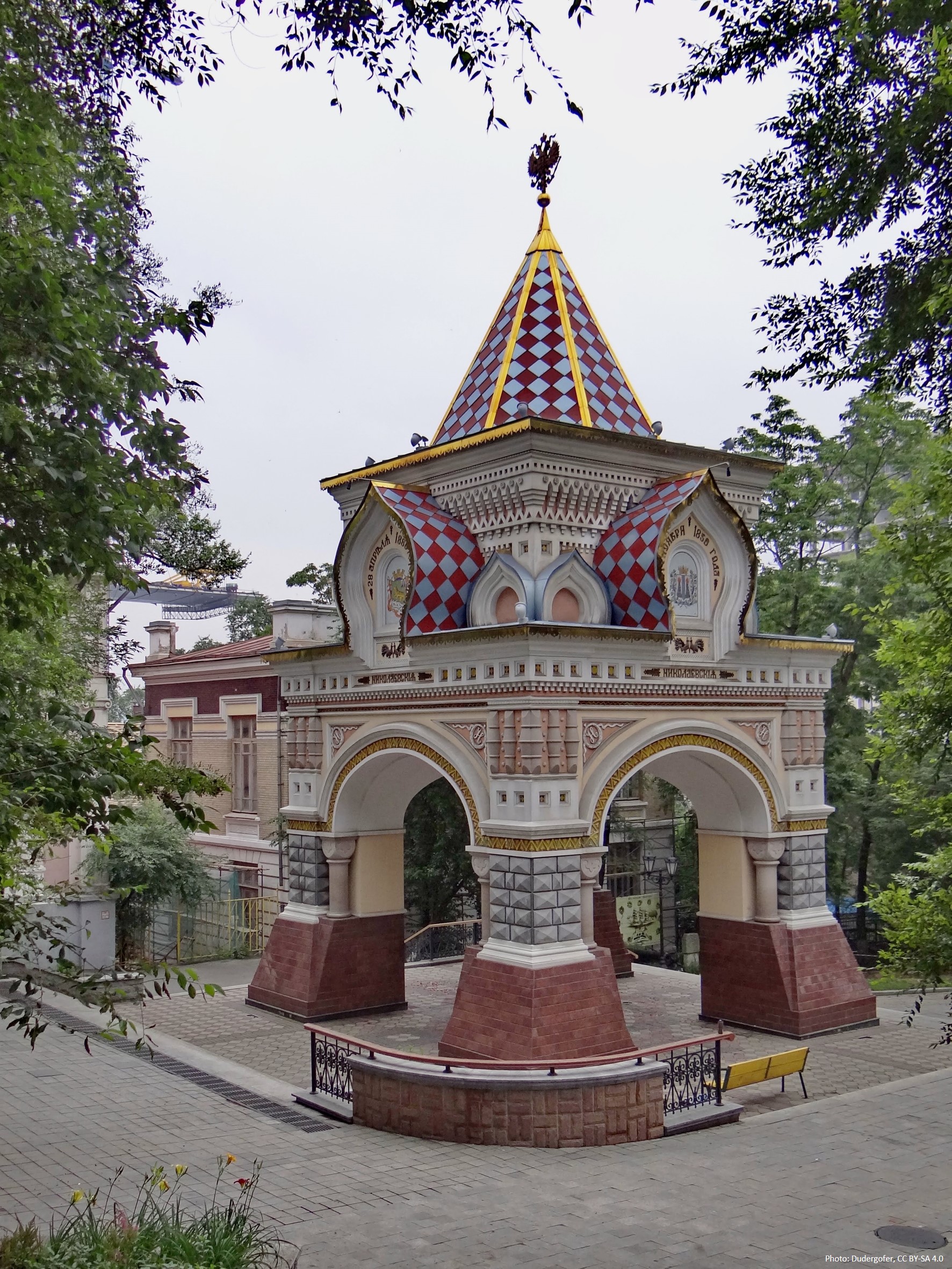
On May 11, 1891, the future Czar Nicholas II visited Vladivostok. This happened in connection with the start of the construction of the Trans-Siberian Railway, and a beautiful triumphal arch was erected for the occasion. As a monument to the czarist era, the arch was torn down in the Soviet Union. The present triumphal arch is therefore a reconstruction of the original one, it was inaugurated in 2003.
This lighthouse, also called Egersheld Lighthouse, has since 1876 been located very picturesquely at the end of a narrow and rocky headland at the entrance to the port of Vladivostok.
The current tower dates from 1910 and is a place that most visitors to the city would like to get to for experiencing the view of Vladivostok and to the sea on all sides. The lighthouse is named after Gustav Egersheld, who explored the area around Peter the Great’s Bay near Vladivostok in the mid-19th century.
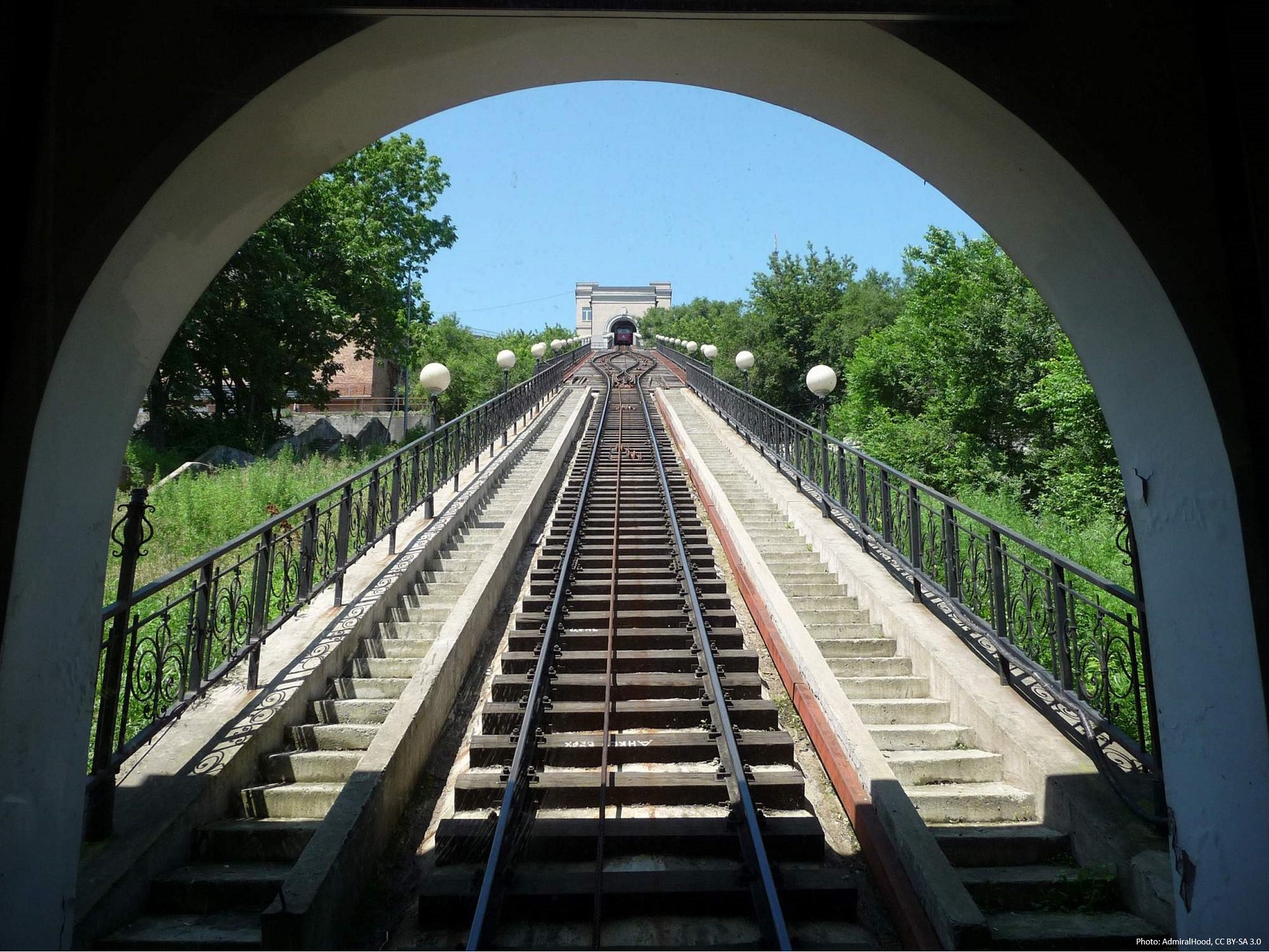
This cable car is one of the only of its kind in Russia. The track consists of two carriages that, so to speak, pull each other up and down at each end of the same cable. The funicular runs between the streets Pushkinskaya and Skuhanova, and at the top there is access to a beautiful view from the highest point in the center of Vladivostok, called the Eagle’s Nest Hill/Орлиное Гнездо. The track was opened in 1962 and the stretch measures 183 meters/600 feet.
Mariinsky Theater in St. Petersburg is the finest theater in Russia together with the Bolshoi in Moscow. Since 2013, the theater has had this department in Vladivostok with many distinguished productions since its opening. You can experience opera, ballet and fine concerts here, where the modern theater building itself is an experience.
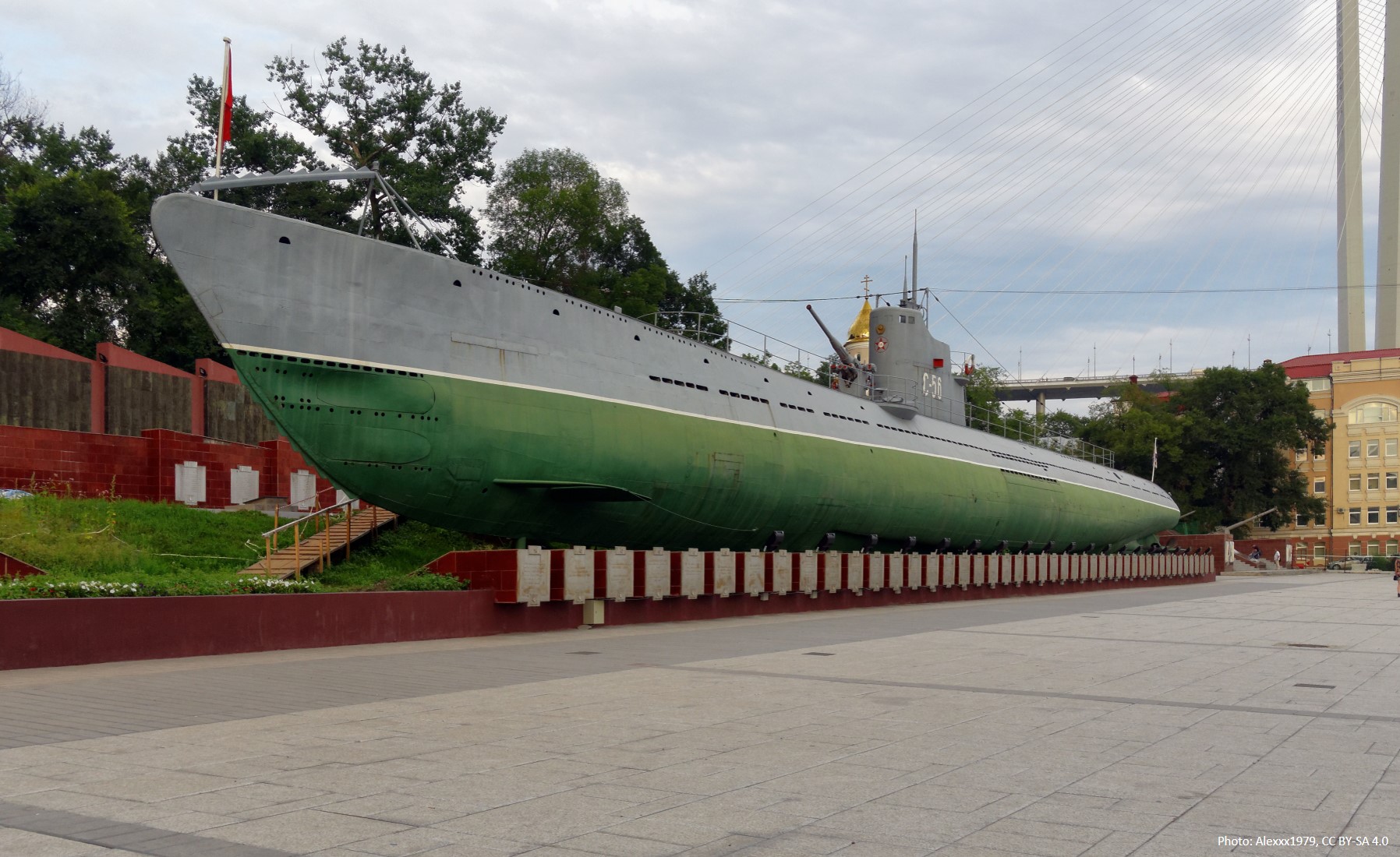
The submarine S-56 was built in Leningrad from 1936 to 1939 and was in active operation for the Soviet Navy during World War II. The submarine’s crew sank four German ships in 1943 and 1944. The submarine is 77.8 meters/255 feet long and it could sail at a speed of 9 knots when submerged. Since the 1970s, the submarine has been displayed on land in Vladivostok, and it is open as a museum.
Vladivostok Fortress is a colossal military facility that was built in many places in and around the city of Vladivostok. The development started in 1889 and expanded after Japan’s attack on Port Arthur in 1904 and the city’s fall the following year.
With the loss of Port Arthur and parts of Manchuria in 1905, Vladivostok became further strategically important to Russia, and the fortress was expanded until 1917. In 1996, this museum opened, where you can see the exciting history of the fortress.
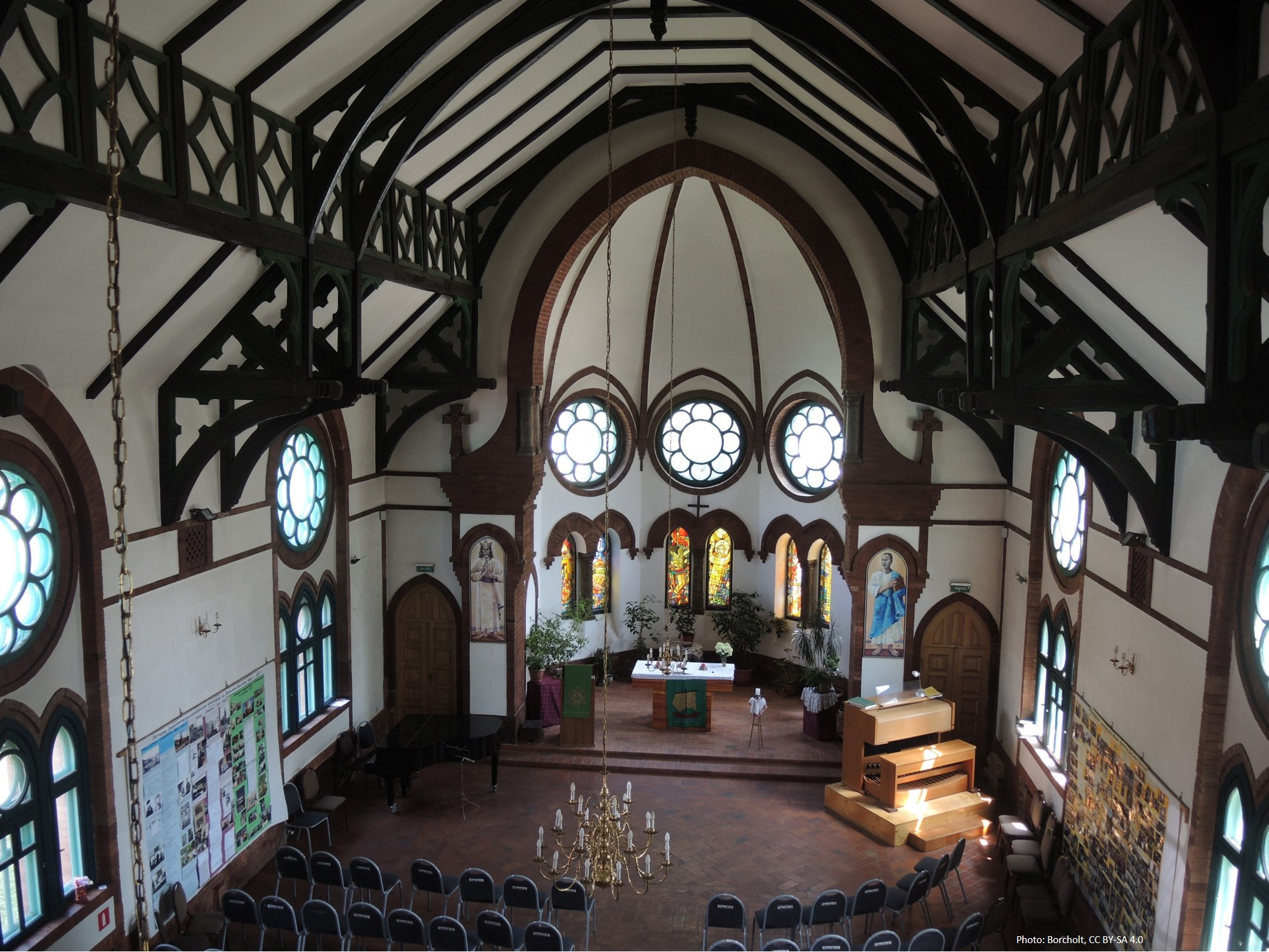
This church was built in 1907 according to the design by a German architect. It stands as Vladivostok’s oldest church, and it is also Russia’s easternmost Lutheran church. The church was erected for the Protestant congregation in the city, which numbered several thousand people, mainly from Germany. From 1935 to 1992, the church was used as a club, cinema and a museum, before it became a church again.
Millionka is one of the old quarters of Vladivostok, located in the area around the street ulitsa Admirala Fokina. Historically, it was a tough neighborhood with brothels, gambling clubs and opium dens run by Chinese gangs. Red brick houses with balconies dominated Millionka, which was stormed by the NKVD in 1936 and brought to order. Today you can see the remains of the old buildings, and here are cafes and galleries that give a special atmosphere.
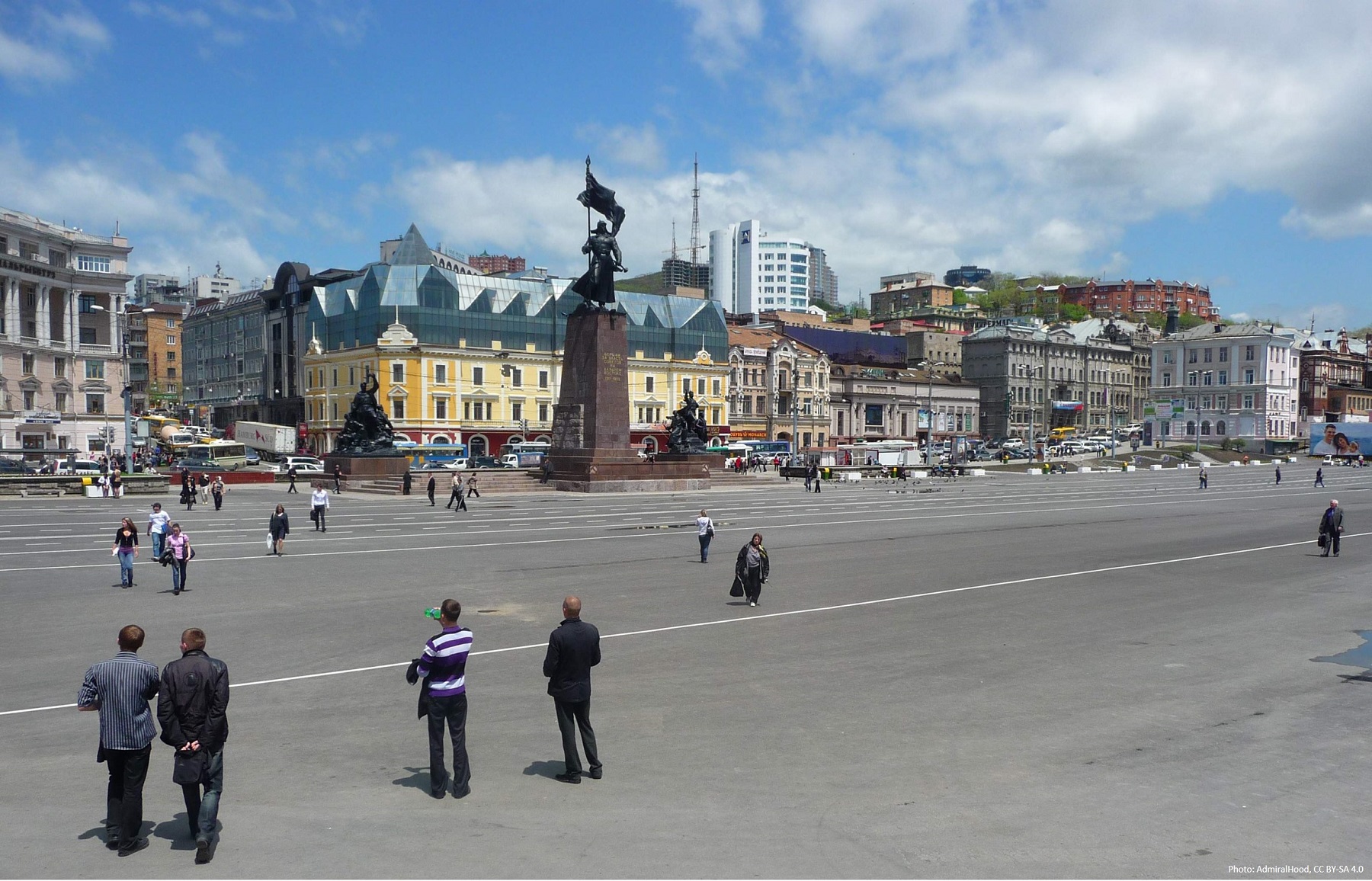
This is the central square in Vladivostok, and here are some sights to see. You can see Monument to the Fighters for Soviet Rule in the Far East/Памятник Борцам за Власть Советов на Дальнем Востоке, which was unveiled in 1962 and is one of Vladivostok’s most famous monuments. It is a memorial to those who fought for the Soviet Union in the years 1917-1922 in the Far East.
On the Square of the Revolutionary Fighters you can see this high-rise building, which was inaugurated in 1983 as the regional Soviet, Dom Sovetov/Дом Советов, which means the government building of the Primorsky region. The function of the building has continued, but now it is for the Russian and not Soviet region. The house was at the opening the highest in Vladivostok.
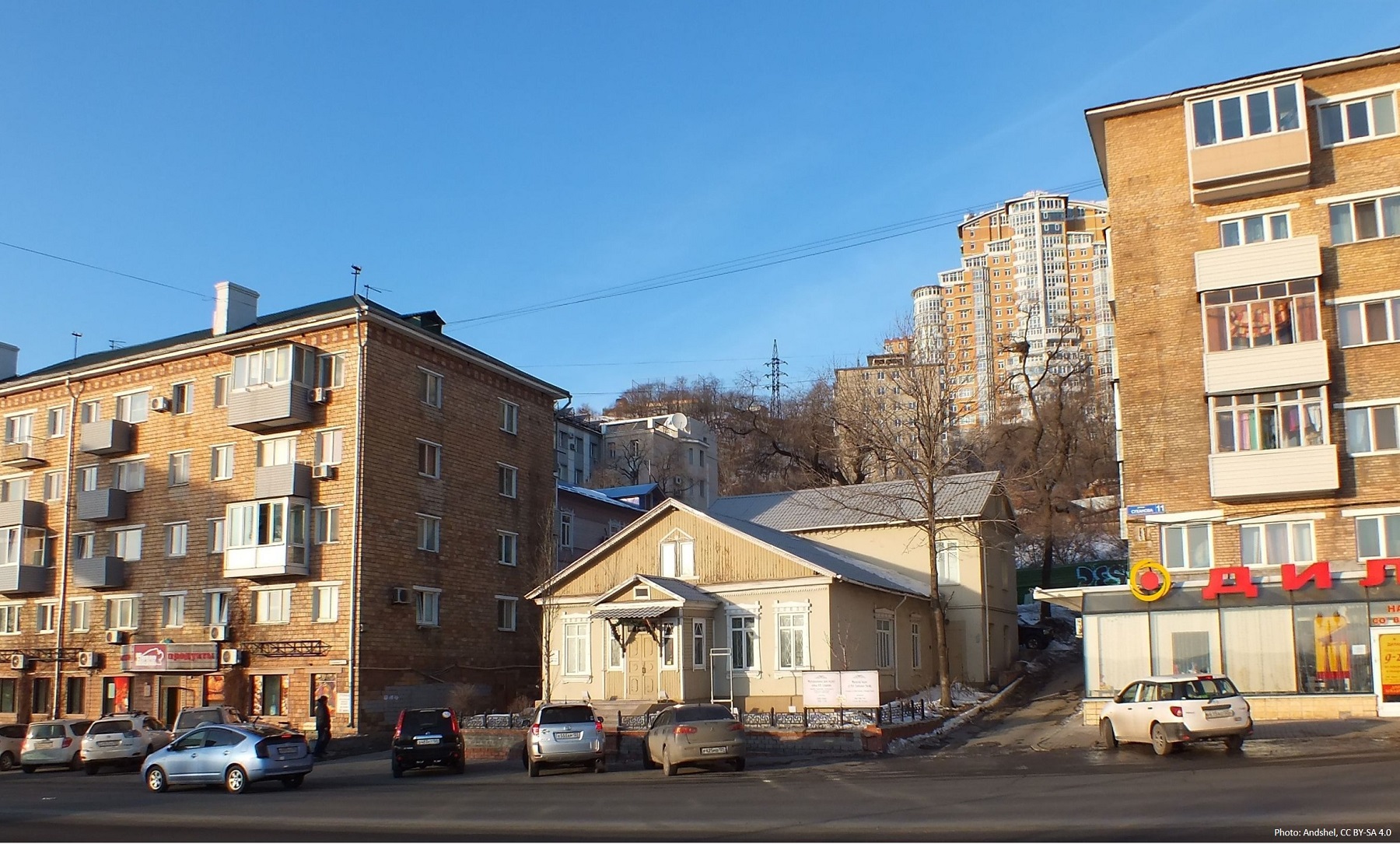
The Sukhanov House Museum is a museum for an official in the Vladivostok serving in the czarist era. Alexander Sukhanov was the state adviser to the regional government of the area, and it is in his residence that the museum is now housed. Sukharov’s time was historically interesting, and the museum is also interesting because the house is one of the preserved wooden mansions from the 19th century Vladivostok. Today, it is located in the street scene as a nice contrast to modern neighboring buildings.
At this art museum you can see large and fine collections of visual art from the last many centuries. There is a large collection of Russian works from the 1700s-1900s at the museum, and you can also see works by European artists from the 1300s-1800s. There is also exciting local art with works from the Russian Pacific region.
At the beginning of the 20th century, Vladivostok was the center of immigration of about 3,500 Japanese, who eventually formed a Japanese community in need of diplomatic assistance. In 1912, Russia entered into a trade agreement with Japan, and with it, a Japanese consulate was opened in the city. The consulate building, which is today a Russian courthouse, was opened in 1916 after a design by Jakob Shafrat.
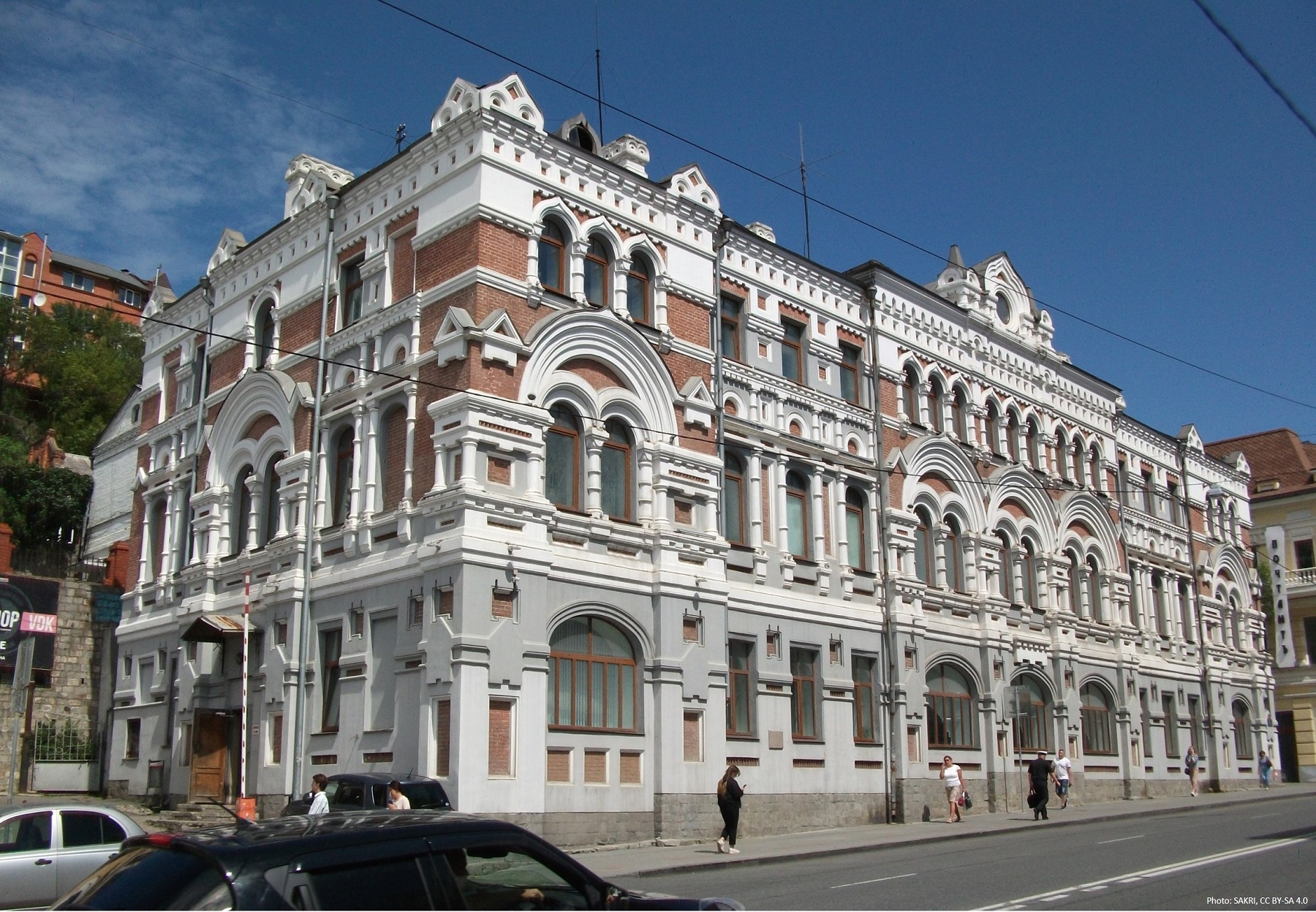
The main post office in Vladivostok is located as one of the most beautiful buildings on the main street of ulitsa Svetlanskaya. It was built in 1897-1899 as a replacement for a smaller post office. It was a time when the post office had become very efficient compared to previous years’ very slow delivery of mail and newspapers to cities in the Far East. The beautiful architecture of the house is so-called neo-Russian, where it was built with inspiration from the 17th century.
The history of this theater goes back to its founding in 1931 and the first production in 1932, which was The Street of Joy/Улица радости. Today it is one of the city’s leading and largest theaters with many beautiful performances. There are two stages in the modern theater building, which opened in 1975.
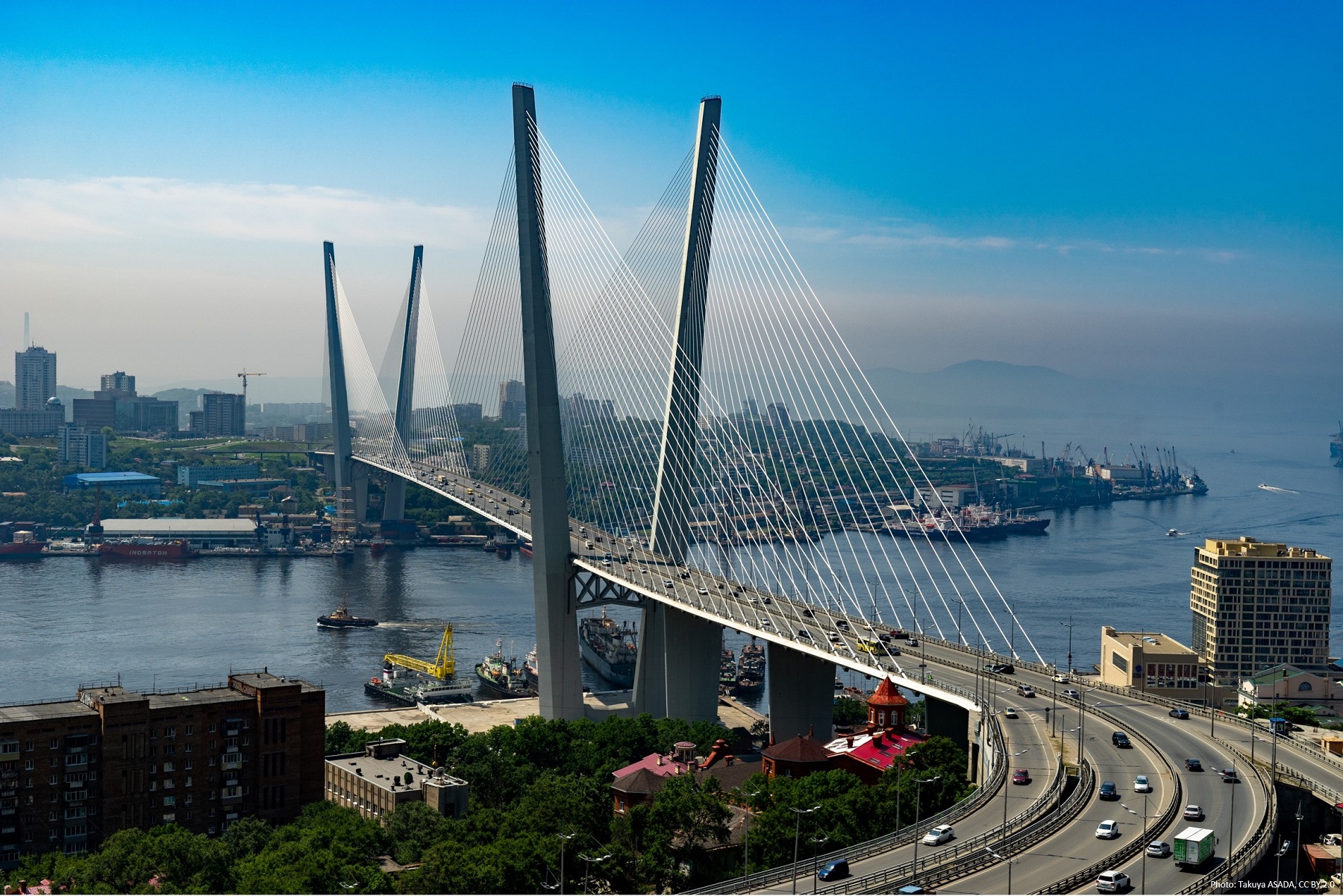
Zolotoi Most means The Golden Bridge, and the name comes from the fact that the bridge crosses the Golden Horn/Золотой Рог, which is a bay that in a shape of a horn cuts into the center of Vladivostok. The bridge was built in the years 2008-2012, and it stands as one of the city’s modern landmarks. Together with the corresponding new bridge to the island of Ostrov Russky, Zolotoi Most has made the journey to the south of the city much faster.
The Russian Bridge is a cable-stayed bridge that opened in 2012 with the world’s longest span between the pylons. The span is 1,104 meters/3,622 feet and the height of the bridge is an impressive 320.90 meters/1,053 feet. It connects the Russian mainland with the island of Ostrov Russky. On the island, the international APEC Russia 2012 summit was held and it was on that occasion that the bridge was built.
ulitsa Svetlanskaya 35/улица Светланская 35
vladgum.ru
ul. Kalinina 8/ул. Калинина 8
kalinamall.ru
ul. Cheromukhovaja 15/ул. Черёмуховая 15
trccheremushki.ru
Ulitsa Svetlanskaya/улица Светланская, ulitsa Admirala Fokina/улица Адмирала Фокина
Primorsky Okeanarium/Приморский океанариум
ul. Akademika Kasjanova 25/ул. Академика Касьянова 25
ostrov Russky/остров Русский
primocean.ru
Muzej Podvodnaya Lodka S-56/Музей Подводная лодка С-56
Korabelnaya Naberezhnaya/Корабельная Набережная
Zoopark Sadgorod/Зоопарк Садгород
ul. Vorovskogo 24-B/ул. Воровского, 24-б
Okean/Океан
Naberezhnaya ulitsa 3/Набережная улица 3
Park Attraktsionov Fantaziya/Парк аттракционов Фантазия
100-letiya Vladivostoka pr. 105 A/100-летия Владивостока пр. 105 А
Vladivostok, located in the far eastern part of Russia, has a rich and varied history. Its strategic position on the Pacific coast, near the borders of China and North Korea, has shaped its development and significance over the centuries.
Before the arrival of the Russians, the area that is now Vladivostok was inhabited by the indigenous Udege people and, later, by the Jurchen and the Manchu tribes. In the mid-19th century, the territory was part of the Qing Dynasty in China.
The city’s modern history began in 1858, when the Treaty of Aigun ended the Second Opium War between Russia and China, transferring the region to Russian control. In 1860, the territory around Vladivostok was incorporated into the Russian Empire with the Treaty of Peking.
Vladivostok, meaning “ruler of the east” in Russian, was founded in 1860 as a military post. The construction of the Trans-Siberian Railway, completed in 1905, turned Vladivostok into a vital transportation hub connecting European Russia with its eastern territories.
Vladivostok was the main staging point for the Russian Pacific Fleet in the Russo-Japanese War (1904-1905), but the city was not directly attacked. Following the Russian Revolution in 1917, the city was occupied by foreign powers, including Japan and the United States, during the Russian Civil War.
In 1922, Vladivostok became part of the Far Eastern Republic, a buffer state between Soviet Russia and Japan. It was not until 1922 that the city was officially incorporated into the Soviet Union.
During World War II, Vladivostok was a critical part of the Pacific theater. As a major Pacific port, the city served as a hub for supplies from the United States under the Lend-Lease Act.
In the post-war period, Vladivostok grew in economic and military importance, housing the Soviet Union’s Pacific Fleet. However, due to its strategic significance, the city was closed to foreigners from 1958 until the dissolution of the Soviet Union in 1991.
With the collapse of the Soviet Union, Vladivostok opened up to the world. It has since been actively developing its economic, cultural, and educational ties with other countries. In 2012, the city hosted the 24th APEC summit, a significant international event that boosted the city’s profile.
Today, Vladivostok is Russia’s largest port on the Pacific Ocean and is the administrative center of Primorsky Krai. It’s known for its beautiful hills, bays, and islands, and is home to several universities, theaters, and a vibrant arts scene.
From its origins as a military outpost to its current status as a bustling port city, Vladivostok has a rich history that reflects Russia’s evolving relationship with the Pacific region.
Overview of Vladivostok
Vladivostok is one of Russia’s easternmost cities, and it is an interesting city, and in many ways a trip here is like being in Europe despite its location on the Russian Pacific coast. In this way you experience both the rich Russian culture and local history and culture.
For many visitors, Vladivostok is the same as the terminus of the Trans-Siberian Railway and thus the destination of a great journey. It is, too, but the beautifully situated metropolis has so many sights, museums and activities that it is worth visiting by itself without necessarily taking on the 9,288 km/5,771 mile long train journey from Moscow.
A walk along the main street of Svetlanskaya is a must when being in Vladivostok. Here you will see many of the beautiful constructions from the early 20th century Vladivostok. The walks along the water and the view from Eagle’s Nest Hill must also be a part of the stay, and you should also have the walk to Egersheld Lighthouse on the city bucket list, here you have the sea on all sides.
Vladivostok’s surroundings are also exciting with good opportunities for activities. For example, you can take the Trans-Siberian Railway to the west and just get off in Khabarovsk or another station close to the city. The city’s oceanarium is also worth a visit, and the borders with China and North Korea are also in close distance from here.
About the travel guide to Vladivostok
Number of trips: X trips in the city + trips in the area
Pages: Coming soon
Published: Coming soon
Author: Stig Albeck
Publisher: Vamados.com
Language: English
ISBN: 978-87-93491-XX-X
About the travel guide to Vladivostok
The travel guide to Vladivostok gives you an overview of sights and experiences in the German city. Read about top attractions and other sights, and buy a travel guide with tour suggestions and descriptions of all the city’s most important churches, monuments, mansions, museums, etc.
Vladivostok is waiting for you, and on vamados.dk you can also find cheap flights and good deals on hotels for the trip. You just choose your travel dates and then you get suggestions for flights and accommodation in and around the city.
Read more about Vladivostok and Russia
Russia information: vamados.com/russia
Vladivostok tourism: visittyumen.ru
Russia tourism: russiatourism.ru
Russian railways: rzd.ru
Vladivostok Airport: aerochita.ru
Buy the travel guide
Click on the “Put in shopping cart” button to buy the travel guide. Then you come to the payment, where you enter purchase and payment information. After completing payment of the guide, you will immediately receive a receipt with a link to download your purchase. You can thus download the guide immediately or use the download link in the email later.
Use the travel guide
When you buy the travel guide to Vladivostok, you get the book online, so you can have it on your mobile, tablet or computer – and you can of course also choose to print it. Use the maps and tour suggestions, and you will have a good and meaningful journey.
Egersheld Lighthouse • Trans-Siberian Railway • Svetlanskaya • Pacific

This cable car is one of the only of its kind in Russia. The track consists of two carriages that, so to speak, pull each other up and down at each end of the same cable. The funicular runs between the streets Pushkinskaya and Skuhanova, and at the top there is access to a beautiful view from the highest point in the center of Vladivostok, called the Eagle’s Nest Hill/Орлиное Гнездо. The track was opened in 1962 and the stretch measures 183 meters/600 feet.
Mariinsky Theater in St. Petersburg is the finest theater in Russia together with the Bolshoi in Moscow. Since 2013, the theater has had this department in Vladivostok with many distinguished productions since its opening. You can experience opera, ballet and fine concerts here, where the modern theater building itself is an experience.

The submarine S-56 was built in Leningrad from 1936 to 1939 and was in active operation for the Soviet Navy during World War II. The submarine’s crew sank four German ships in 1943 and 1944. The submarine is 77.8 meters/255 feet long and it could sail at a speed of 9 knots when submerged. Since the 1970s, the submarine has been displayed on land in Vladivostok, and it is open as a museum.
Vladivostok Fortress is a colossal military facility that was built in many places in and around the city of Vladivostok. The development started in 1889 and expanded after Japan’s attack on Port Arthur in 1904 and the city’s fall the following year.
With the loss of Port Arthur and parts of Manchuria in 1905, Vladivostok became further strategically important to Russia, and the fortress was expanded until 1917. In 1996, this museum opened, where you can see the exciting history of the fortress.

This church was built in 1907 according to the design by a German architect. It stands as Vladivostok’s oldest church, and it is also Russia’s easternmost Lutheran church. The church was erected for the Protestant congregation in the city, which numbered several thousand people, mainly from Germany. From 1935 to 1992, the church was used as a club, cinema and a museum, before it became a church again.
Millionka is one of the old quarters of Vladivostok, located in the area around the street ulitsa Admirala Fokina. Historically, it was a tough neighborhood with brothels, gambling clubs and opium dens run by Chinese gangs. Red brick houses with balconies dominated Millionka, which was stormed by the NKVD in 1936 and brought to order. Today you can see the remains of the old buildings, and here are cafes and galleries that give a special atmosphere.

This is the central square in Vladivostok, and here are some sights to see. You can see Monument to the Fighters for Soviet Rule in the Far East/Памятник Борцам за Власть Советов на Дальнем Востоке, which was unveiled in 1962 and is one of Vladivostok’s most famous monuments. It is a memorial to those who fought for the Soviet Union in the years 1917-1922 in the Far East.
On the Square of the Revolutionary Fighters you can see this high-rise building, which was inaugurated in 1983 as the regional Soviet, Dom Sovetov/Дом Советов, which means the government building of the Primorsky region. The function of the building has continued, but now it is for the Russian and not Soviet region. The house was at the opening the highest in Vladivostok.

The Sukhanov House Museum is a museum for an official in the Vladivostok serving in the czarist era. Alexander Sukhanov was the state adviser to the regional government of the area, and it is in his residence that the museum is now housed. Sukharov’s time was historically interesting, and the museum is also interesting because the house is one of the preserved wooden mansions from the 19th century Vladivostok. Today, it is located in the street scene as a nice contrast to modern neighboring buildings.
At this art museum you can see large and fine collections of visual art from the last many centuries. There is a large collection of Russian works from the 1700s-1900s at the museum, and you can also see works by European artists from the 1300s-1800s. There is also exciting local art with works from the Russian Pacific region.
At the beginning of the 20th century, Vladivostok was the center of immigration of about 3,500 Japanese, who eventually formed a Japanese community in need of diplomatic assistance. In 1912, Russia entered into a trade agreement with Japan, and with it, a Japanese consulate was opened in the city. The consulate building, which is today a Russian courthouse, was opened in 1916 after a design by Jakob Shafrat.

The main post office in Vladivostok is located as one of the most beautiful buildings on the main street of ulitsa Svetlanskaya. It was built in 1897-1899 as a replacement for a smaller post office. It was a time when the post office had become very efficient compared to previous years’ very slow delivery of mail and newspapers to cities in the Far East. The beautiful architecture of the house is so-called neo-Russian, where it was built with inspiration from the 17th century.
The history of this theater goes back to its founding in 1931 and the first production in 1932, which was The Street of Joy/Улица радости. Today it is one of the city’s leading and largest theaters with many beautiful performances. There are two stages in the modern theater building, which opened in 1975.

Zolotoi Most means The Golden Bridge, and the name comes from the fact that the bridge crosses the Golden Horn/Золотой Рог, which is a bay that in a shape of a horn cuts into the center of Vladivostok. The bridge was built in the years 2008-2012, and it stands as one of the city’s modern landmarks. Together with the corresponding new bridge to the island of Ostrov Russky, Zolotoi Most has made the journey to the south of the city much faster.
The Russian Bridge is a cable-stayed bridge that opened in 2012 with the world’s longest span between the pylons. The span is 1,104 meters/3,622 feet and the height of the bridge is an impressive 320.90 meters/1,053 feet. It connects the Russian mainland with the island of Ostrov Russky. On the island, the international APEC Russia 2012 summit was held and it was on that occasion that the bridge was built.
Similar to Vladivostok Travel Guide
There are no listings matching your search.
Reset